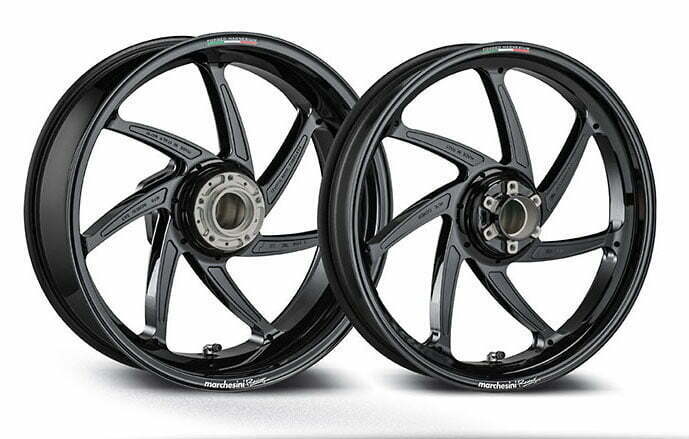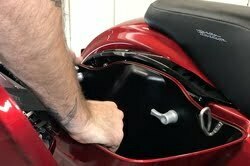Behind The Design Of Motorcycle Wheels

Today, the variety of wheel styles is practically endless.
Illustration by Tim Barker
This article was originally published in the April-May 1997 issue of Cycle World’s Big Twin magazine.
Wheels, beautiful wheels, flashing spokes, whirling, sparkling shapes in motion—their variety has become practically endless. There are cast wheels, traditional wire wheels, die-stamped wheels, even rotary forged or spun wheels. There are wheels with CNC-machined spokes, wheels with slots and fins and stars.
Lots to see, but what is there to know about wheels? How are they made? What are their strengths and weaknesses? How are they tested? And perhaps most important of all, why should I care?
Let’s start at the obvious place—the beginning. The very first motorcycle had wooden wheels because it was an alien machine intruding into a buggy age. By the turn of the century, motorcycles and bicycles rolled on wire-spoked wheels with metal or wood rims—though the tension-spoke wheel dates back almost 200 years to the water-wheels of Thomas Hewes. Wire wheels, with their threaded spokes and tension-adjusting nipples, dimpled and drilled rims, are an arcane craftsman’s mystery to many of today’s riders, accustomed as they are to the seeming automatic integrity of cast motorcycle wheels. But wire wheels have a sense of their own, and once you’ve had the experience of lacing and trueing, they explain themselves.
Racing cars switched from wire to cast wheels in the late 1950s. And by 1968, Peter Williams, an English racer and engineer, had made such wheels for motorcycles.
In racing, where use of an inner tube adds to tire temperature, the opportunity to run tubeless was valuable. As experience accumulated, it also became clear that tubeless tires were actually more resistant to sudden deflations than tires with tubes, and this quality was valuable to any potential user. Indeed, in Europe, one of Harley’s contracted racers experimented in the late 1960s with tubeless operation on a carefully sealed wire-spoked wheel.
Here in the U.S., Dan Hanebrink and his Monotrack firm offered cast-magnesium motorcycle racing wheels by 1971. Shortly after that, Californian Elliot Morris—who had previously helped auto mag-wheel pioneer Ted Halibrand set up production—produced aluminum and magnesium motorcycle wheels for racing and street use. These were widely used by race teams both here and abroad, and their reliability did much to stimulate other producers. In the later ’70s, Tom Lester, long a producer of precise automotive castings, created a modular system of die-cast motorcycle wheels, clearly hoping for OEM interest. By 1980, several production motorcycles rolled on cast wheels, and tubeless motorcycle tires had truly arrived.
Curiously, a call to the Tire and Rim Association revealed that there are no mandatory Federal wheel-test standards, even in our highly-regulated airbag era. Numbers 119 and 120 of the Federal motor vehicle standards cover motorcycle wheels, but require no qualifying tests. Morris was a pioneer in this respect, applying modified aircraft wheel tests to his own products; if you’re going to be a pioneer, you don’t want to give the whole enterprise a bad name by making junk.
Wheel-test methods are available from the SAE (Society of Automotive Engineers), and from military and civil aviation authorities. They cover pretty much what you’d expect: air containment, vertical and lateral loads necessary to produce permanent deformation, burst and drop tests, a 15,000-mile double-load rolling test, and so on. Many of these tests require the use of fancy equipment—powered drums with equipment to press test wheels and tires against them; set-ups to static-load wheels, employing dial gauges to detect deformations; on-bike accelerometers to detect vertical or lateral accelerations that may arise from cyclic wheel deformations during sustained hard cornering (wobbling, bending between spokes, etc.).

The M7R Genesi is an example of a forged magnesium wheel from Marchesini.
Marchesini
Cast wheels have been made in one piece, or with a hollow hub to which bearing, disc and sprocket carriers are bolted. This multitude of parts places a premium on machining accuracy. Another hollow-hub scheme, that of Lester, provided a variety of weld-in hub inserts that would adapt one basic wheel casting to many applications.
Obviously, cast wheels lend themselves better to disc than to drum brakes. Because the rim area is subjected to high stress—not only from load and road shock, but also from tire-inflation pressure, which acts to bend and overturn the rim flanges—there have likewise been designs that attach an extruded or sheet-metal rim to a cast or machined hub and spokes.
“For many people, the clean visual simplicity of a spoked wheel laced on a spool hub can’t be improved upon.”
Magnesium, because of its chemical reactivity and internal changes that occur with age, is not a good material for street wheels, however exotic it seems. Aircraft mag wheels must periodically be stripped of their protective epoxy paint, then inspected for possible cracks by die-penetrant. If they pass, they are surface-prepped and re-coated. If they fail, they’re scrapped. Not a recipe for carefree motoring.
Some designers are attracted to the lightness, strength and ductility of sheet materials. One way to employ them is to extrude a rim section with a central, inward-facing flange, to which flat spokes can then be riveted, joining a pair of similar flanges machined onto a billet hub. Alternatively, the hub and spokes can be cast. In another variant, the spoke assembly is machined from plate, then joined to a turned-from-bar hub and an extruded rim.
New varieties of wire-spoked wheels have entered the market, with as many as 100 spokes. For many people, the clean visual simplicity of a spoked wheel laced on a spool hub can’t be improved upon. For many years, spools were the universal wheel that allowed you to run a bike on dirt or in roadraces, just by changing what was or was not attached to the faces of spools. This cachet of tradition remains powerful.
Another design is the “pie-plate” wheel, inspired by the Centerline wheels used on drag cars. A pair of die-stampings (or, for low production, spinnings) is made, each forming half of the rim and one of a pair of supporting conical webs. These are then riveted, welded or otherwise joined together over a hub to form a complete wheel that is very light and stiff.
There’s a new wheel production method that’s what we might call “rotary plastic forming.” An aluminum slug or blank is forged, giving it a dense grain structure; this blank is then mounted on a special machine and rotated, hot, while a variety of tools roll and form the blank into a one-piece wheel and rim, much as the hands of a potter form a rotating blob of clay into a graceful vessel. This system is attractive because the resulting wheel is effectively forged, giving it maximum strength for its weight. The density of the material also allows the wheel to receive chrome plating that is without the inconsistency characteristic of chrome on cast aluminum. The resulting wheel is then finish-machined to exact dimension. Motorcycle wheels are now being made via this process by a firm in Florida, and by BBS, makers of auto-racing wheels in Europe.
Casting is an ancient art, today extremely sophisticated. In general, it is best if all parts of a casting have a similar thickness, as this ensures equal cooling rates throughout. Thick sections remain hot and weak longer, and may be torn by contraction of faster-cooling parts of the casting. Smooth shapes cast better than sharp edges.
Makers of non-cast wheels like to point to common casting problems, such as porosity, as evidence of weakness. Truth is, however, that cast parts, properly made and heat-treated, are extremely strong. At one end of the spectrum are low-production castings, poured in traditional sand molds. Careful design and inspection can produce excellent parts this way. More sophisticated is vacuum casting, in which metal is vacuum-drawn into the mold from a liquid-metal reservoir below it. The vacuum extracts gases that might otherwise cause porosity. In die-casting, liquid metal is injected into heated, permanent metal molds, where it cools at carefully engineered rates to produce uniformly excellent pieces with smooth surface finish.
“Casting is an ancient art, today extremely sophisticated.”
Test data revealed by Lester 20 years ago showed some surprises. One of the most durable wheels he had tested was a traditional steel-rimmed Harley wire-spoked wheel. It held its shape under heavy load and did not crack after prolonged loaded rolling tests. Wire wheels with aluminum rims were less strong—as you’d expect from a metal with only 1/3 the stiffness of steel. There is nothing whatsoever wrong with wire-spoked wheels where strength is concerned, and there are even some designed to permit tubeless operation. There is also nothing wrong with aluminum as a rim material. The wheels of large aircraft, often carrying take-off loads as high as 40,000 pounds each, are aluminum.
In a way, one important new type of wheel owes its existence to Secretary Gorbachev of the former Soviet Union. The end of the Cold War has switched a lot of sophisticated U.S. machine shops from defense work to consumer goods. This encouraged some of these shops to design custom motorcycle wheels that could be manufactured on their CNC equipment. These are the wheels with an extruded rim, fastened to a machined-from-plate “spider,” or spoke assembly, which is secured to a turned-from-bar hub. Wheels of this type may be offered with style-matched brake-disc carriers, sprockets or belt pulleys. The spokes may be straight, scimitar-like or any desired shape, often with patterns or motifs machined into their surfaces.
Because of the nature of the machines producing this work, accuracy is built-in, and the style can be changed as quickly as a computer disc. In our era, it no longer depends upon an hourly worker trying to stay awake and remember that it’s got to be 17 turns of the crossfeed, plus a hundred and eighty-six thousandths. CNC machines don’t get tired or bored, or forget what they’re doing.
Rim extrusions are manufactured by forcing aluminum, in a plastic state, through an extrusion die. This stock is cut to length, rolled to circular form, and welded to make a continuous hoop. This is a very old technology previously used to make light weight racing rims for wire-spoked wheels.
How accurate is good enough? It used to be that in lacing a wire wheel, a vertical or lateral run-out of .020-inch was all the service book required; but a good man with a new rim of high quality might easily divide that figure by four—save for the little bump at the weld. A wheel that good is good enough: .005-inch is very small by comparison with normal variations in tire roundness. Spin any mounted tire and have a look for yourself.
Nevertheless, wheel manufacturers whose rim channels are machined, rather than stamped or extruded and rolled, like to point righteously to the extra accuracy of their wheels. They’re right: Nothing can beat a machined wheel for close-to-zero run-out. Maybe you care, but to anyone who really understands the realities of how the rubber meets the road, this is like a carpenter sizing wall studs to a .001-inch length tolerance: Tomorrow the weather will be different and so will the studs. Similarly, mount a rubber tire on your perfect wheel and measure again!
In standard rim contours, the tire bead slides up a slight ramp to seat against the rim flange. Typically, there is some interference here (the rim’s outside-diameter is slightly bigger than the tire’s inside-diameter) to make a tight seal for tubeless use and/or to ensure a slip-free power transfer from rim to tire. An alternative design requires the bead to first slide over a little hump on its way to the flange. This hump is the so-called “safety bead” whose purpose is to hold the tire on the rim even if inflation pressure is lost.
Cautions about wheels have to do with tire changing and mounting. Cast wheels have been broken and other types bent or badly gouged by inexperienced tire-changers using long, automotive tire levers or, even less appropriate, screwdrivers. The rule is that if you can’t get the tire on with 6-inch levers, you’re doing it wrong and should have your tire-mounting done by professionals.
When it’s time to inflate the tire, remember the rule: Never use more than 60 psi for bead seating. Many people have been badly hurt when they resorted to excessive pressure (some using as much as 180 psi) to seat a bead. The tire can expand enough to climb over the rim, resulting in an explosive failure.
One other bit of wheel-related advice: Wheels roll on stacked assemblies of bearings and spacers, which must be sized precisely so that as you tighten the axle nut, the enormous pressure exerted by the nut does not crowd the bearings against their flanges in the wheel hub. When new wheels are installed, check for perfectly free rotation. Any stiffness may indicate a crowded bearing that could overheat and fail.
As you can see, then, there indeed is a lot to know about wheels. How much you care about it all depends upon your needs; performance riders might be concerned about qualities such as stiffness, strength and unsprung weight, while custom builders may care only about appearance. That’s why new wheels for a rider are like blank notebooks for a writer: No one knows where they will lead.
That’s entirely up to you.







